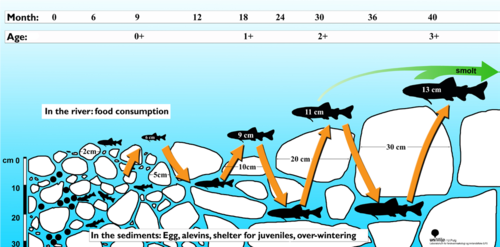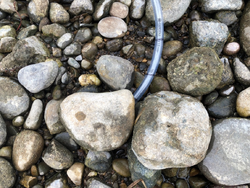Shelter measurements
Contents
Quick summary
Developed by: A. G. Finstad
Date: -
Type: Method
Introduction
The technique was developed by Finstad to estimate the shelter availability for juvenile salmon (Finstad et al. 2007a). In this stage of their life cycle, the salmon seeks shelter in the free spaces of the upper layers of the riverbed sediment (Figure 1). The existence and size of such openings to be used as shelter is measured with the described technique. It is relatively easy to be carried out in the field. The method is based on the idea to mimic the small fish by using a plastic tube, which has the approximate diameter of such a fish.
For salmon, Finstad used tubes with five different diameters (5, 10, 13, 16, 22 mm). As a result of their experiments Forseth et al. (2014) suggest the use of a 13mm tube to conduct the tests in an area of about 0.25m2. The tube is marked according to the three different shelter categories at lengths of 2, 5 and 10 cm to be able to detect certain possible hiding depths. Within the fixed framed area one is aiming to find every hole or opening where one can stick the tube into. The length of the tube (defined by the three rings) which is not visible anymore, defines the potential hiding depth (Figure 2).
The post-processing of the data is quite simple and described in the following section.
The method was developed in and for Norwegian rivers with large grain sizes. It is currently (also in FIThydro) under investigation if, when using it in rivers with a smaller D50, i.e. smaller grain sizes, this relation still applies or another relation becomes relevant.
It should further be applied also to other fish species than the salmon. Therefor additional tubes with diameters of 5 mm and 8 mm are used within the project`s measurement campaigns. These results might then be linked to the D5 and D10 grain diameter of the sediment (Szabo-Meszaros et al 2016).
Application
For the measurement the following material is needed:
- One tube with a diameter of 13 mm and marks (rings) at 2, 5 and 10 cm
- One frame (metal or wood) to define the size of the area to be counted on
- Something to take notes (Laptop, paper, etc.)
The hiding depth thresholds are defined as 2, 5 and 10 cm and often named as class S1 (2 cm – 5 cm), class S2 (5 cm – 10 cm) and class S3 (> 10 cm). It is recommended that the same person is carrying out the counting, to minimize the human based systematic error as much as possible.
When all values are collected in the field, the counted numbers for the different classes / hiding depth per spot are weighted using the following empirical formula described in Forseth et al (2014):
Based on the following matrix the shelter availability can be defined:
|
Shelter Class |
Low |
Moderate |
High |
|
Values for weighted shelter |
< 5 |
5 – 10 |
> 10 |
Relevant mitigation measures and test cases
Other information
Relevant literature
- Finstad, A.G., Einum, S., Forseth, T., Ugedal, O., 2007a. Shelter availability affects behaviour, size-dependent and mean growth of juvenile Atlantic salmon. Freshwater Biology 52, 1710–1718. https://doi.org/10.1111/j.1365-2427.2007.01799.x
- Finstad, A.G., Forseth, T., Ugedal, O., Naesje, T.F., 2007b. Metabolic rate, behaviour and winter performance in juvenile Atlantic salmon. Functional Ecology 21, 905–912. https://doi.org/10.1111/j.1365-2435.2007.01291.x
- Forseth, T., Harby, A., Ugedal, O., Pulg, U., Fjeldstad, H.-P., Robertsen, G., Barlaup, B.T., Alfredsen, K., Sundt, H., Salveit, S.J., Skoglund, H., Kvingedal, E., Sundt-Hansen, L.E.B., Finstad, A., Einum, S., Arnekleiv, J.V., 2014. Handbook for environmental design in regulated salmon rivers (NINA temahefte No. 53). Norsk institutt for naturforskning, Trondheim, Norway.
- Szabo-Meszaros, Marcel, Rüther, N., Alfredsen, K., 2016. Correlation between the shelter of juvenile salmonids and bed substrate, in: Wieprecht, S., Haun, S., Weber, K., Noack, M., Terheiden, K. (Eds.), River Sedimentation: Proceedings of the 13th International Symposium on River Sedimentation (Stuttgart, Germany, 19-22 September, 2016).
- Valdimarsson, S.K., Metcalfe, N.B., 1998. Shelter selection in juvenile Atlantic salmon, or why do salmon seek shelter in winter? Journal of Fish Biology 52, 42–49. https://doi.org/10.1111/j.1095-8649.1998.tb01551.x


